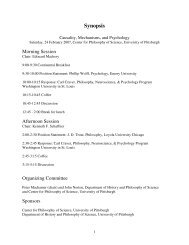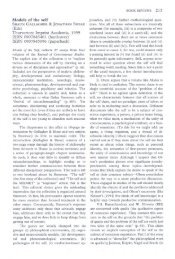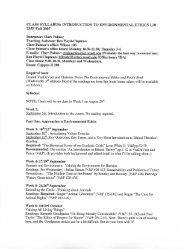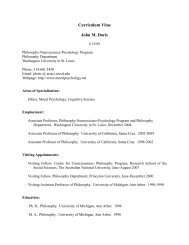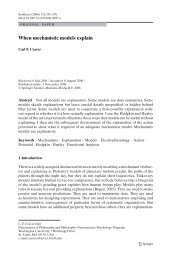The Blackwell Guide to the Philosophy of Science - The Department ...
The Blackwell Guide to the Philosophy of Science - The Department ...
The Blackwell Guide to the Philosophy of Science - The Department ...
You also want an ePaper? Increase the reach of your titles
YUMPU automatically turns print PDFs into web optimized ePapers that Google loves.
<strong>Philosophy</strong> <strong>of</strong> Space–Time Physics<br />
faster-than-light travel). A particle horizon is defined as <strong>the</strong> maximum coordinate<br />
distance that one can see from a given point in space–time. From <strong>the</strong> diagram,<br />
one can see that <strong>the</strong> points at <strong>the</strong> <strong>to</strong>p <strong>of</strong> <strong>the</strong> shaded regions have horizons that<br />
preclude <strong>the</strong>m from seeing each o<strong>the</strong>r’s pasts.<br />
<strong>The</strong> puzzle about horizons arises from <strong>the</strong> fact that a Friedman model like that<br />
pictured can be said <strong>to</strong> fairly represent our universe, where <strong>the</strong> shaded regions are<br />
points in our past where matter decoupled from radiation. Since <strong>the</strong>y share no<br />
common causal past, this means that <strong>the</strong>y have no mechanism in common that<br />
will make <strong>the</strong> microwave radiation’s temperature <strong>the</strong> same. How, <strong>the</strong>n, did <strong>the</strong>y<br />
arrive at <strong>the</strong> same temperature? It seems that, short <strong>of</strong> denying that <strong>the</strong> early universe<br />
can be approximately represented by a Friedman model, <strong>the</strong> only answer is<br />
that <strong>the</strong> universe was “born” in a highly isotropic and homogenous state. This<br />
necessary special initial state is <strong>the</strong> cause <strong>of</strong> <strong>the</strong> horizon problem.<br />
Current work<br />
In physics, <strong>the</strong> main response <strong>to</strong> this puzzle is <strong>to</strong> change <strong>the</strong> physics <strong>of</strong><br />
expansion. Though <strong>the</strong>re are o<strong>the</strong>r responses, <strong>the</strong> one known as inflation is<br />
almost universally maintained. In inflationary scenarios, <strong>the</strong> standard Friedman<br />
expansion is jettisoned in an early epoch in favor <strong>of</strong> a period <strong>of</strong> exponential expansion;<br />
<strong>the</strong> universe <strong>the</strong>n undergoes a phase transition that slows it down back <strong>to</strong><br />
<strong>the</strong> more moderate Friedman expansion. <strong>The</strong> details <strong>of</strong> this period vary with different<br />
proposals (<strong>the</strong>re are more than fifty). Inflation does not remove particle<br />
horizons; instead, it increases <strong>the</strong> size <strong>of</strong> each point’s past null cone so that pairs<br />
will overlap. <strong>The</strong> shaded past lightcones in <strong>the</strong> diagram would intersect while<br />
remaining proper subsets <strong>of</strong> each o<strong>the</strong>r. <strong>The</strong> hope is that <strong>the</strong> common causal<br />
past between two points will be large enough so that it accounts for <strong>the</strong>ir uniform<br />
temperature.<br />
Work by Penrose (1989), Earman (1995) and Earman and Mosterin (1999)<br />
have severely criticized inflation for failing <strong>to</strong> deliver on its original promises. <strong>The</strong><br />
<strong>the</strong>ory, <strong>the</strong>y say, does not rid cosmology <strong>of</strong> <strong>the</strong> need for special initial conditions<br />
<strong>to</strong> explain <strong>the</strong> apparent uniformity <strong>of</strong> <strong>the</strong> cosmic background radiation, nor does<br />
it enjoy much in <strong>the</strong> way <strong>of</strong> empirical success.<br />
Future work<br />
<strong>The</strong> horizon problem shares some general features with o<strong>the</strong>r well-known “problems”<br />
in physics. <strong>The</strong> problem <strong>of</strong> <strong>the</strong> direction <strong>of</strong> time (well, one <strong>of</strong> <strong>the</strong>m) asks<br />
for an explanation <strong>of</strong> <strong>the</strong> <strong>the</strong>rmodynamic arrow <strong>of</strong> time and ends up requiring <strong>the</strong><br />
postulation <strong>of</strong> a very special initial condition <strong>of</strong> low entropy (Price, 1996). Philosophically,<br />
it is non-trivial whe<strong>the</strong>r requiring “special” boundary conditions is a<br />
193



